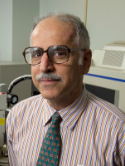| Abstract: |
2,7-Diaminomitosene (2,7-DAM), the major metabolite of the antitumor antibiotic mitomycin C, forms DNA adducts in tumor cells. 2,7-DAM was reacted with the deoxyoligonucleotide d(GTGG-TATACCAC) under reductive alkylation conditions. The resulting DNA adduct was characterized as d(G-T-G-[M]G-T-A-T-A-C-C-A-C) (5), where [M]G stands for a covalently modified guanine, linked at its N7-position to C10 of the mitosene. The adducted oligonucleotide complements with itself, retaining 2-fold symmetry in the 2:1 drug - duplex complex, and provides well-resolved NMR spectra, amenable for structure determination. Adduction at the N7-position of G4 ([M]G, 4) is characterized by a downfield shift of the G4(H8) proton and separate resonances for G4(NH2) protons. We assigned the exchangeable and nonexchangeable proton resonances of the mitosene and the deoxyoligonucleotide in adduct duplex 5 and identified intermolecular proton-proton NOEs necessary for structural characterization. Molecular dynamics computations guided by 126 intramolecular and 48 intermolecular distance restraints were performed to define the solution structure of the 2,7-DAM-DNA complex 5. A total of 12 structures were computed which exhibited pairwise rmsd values in the 0.54-1.42 Å range. The 2,7-DAM molecule is anchored in the major groove of DNA by its C10 covalently linked to G4(N7) and is oriented 3′ to the adducted guanine. The presence of 2,7-DAM in the major groove does not alter the overall B-DNA helical structure. Alignment in the major groove is a novel feature of the complexation of 2,7-DAM with DNA; other known major groove alkylators such as aflatoxin, possessing aromatic structural elements, form intercalated complexes. Thermal stability properties of the 2,7-DAM-DNA complex 5 were characteristic of nonintercalating guanine-N7 alkylating agents. Marked sequence selectivity of the alkylation by 2,7-DAM was observed, using a series of oligonucleotides incorporating variations of the 5′-TGGN sequence as substrates. The selectivity correlated with the sequence specificity of the negative molecular electrostatic potential of the major groove, suggesting that the alkylation selectivity of 2,7-DAM is determined by sequence-specific variation of the reactivity of the DNA. The unusual, major groove-aligned structure of the adduct 5 may account for the low cytotoxicity of 2,7-DAM. |



